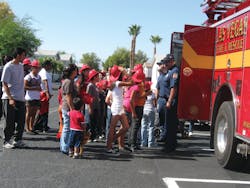Fire Safety Education: Children & Firefighters: How to Interact on a Visit
Ask kids what they want to be when they grow up and many of them will say “a firefighter.” To children, firefighters are heroes and role models – people they can rely on in bad times. It is no wonder they want to visit fire stations or have firefighters visit their school, church or scout group.
Many times after a fire department gets such a request, firefighters wonder how they are supposed to interact and what should they do or show the children. Here are some simple tips:
First, what you do depends on the ages of the children. You are not going to interact with pre-schoolers the same way you would with teenagers. Attention spans and understanding are going to determine how you interact. Pre-schoolers (2 to 5 years old) have an attention span of only three to seven minutes; teenagers can pay attention longer, 20 to 45 minutes in most cases. What you cover will also be determined by what you hope to accomplish. Is it a tour of the station and apparatus or are you focusing on a specific topic, such as how to use 911 during an emergency?
When you receive a request for a visit, you should ask how many children are expected, what their ages are and what subject matter is expected to be covered. Also, request information about adult escorts, such as whether there is an adequate number to handle the group. You are not babysitters; the adults accompanying the children are responsible for them. Also, remind callers that you are an emergency-response organization and the tour may be canceled without notice if you are called to an incident.
At the fire station
All personnel in the station should be advised that visitors are coming. Personnel should be in uniform – remember, this is an impression that may last a lifetime in the eyes of a child. Do you remember the first time you met a firefighter? Make it an impression you are proud of.
Parents or adult escorts should be reminded to watch over the children at all times; no running or climbing on apparatus. A safe area in the station should be designated and pointed out to visitors to go to if an emergency call comes in while you are conducting your tour.
The vehicles are going to be the biggest attraction. Pre-schoolers will only remember the big red truck with lights flashing and sitting behind the steering wheel, which is a good photo opportunity for parents or adult escorts. Older children will want to see more – for teens, pull out a few pieces of equipment, like airpacks or hydraulic rescue tools, and talk about them.
Pulling the rig out on the front pad, pulling the booster line and letting a child flow the nozzle is always a hit. The engine should be at idle no more than 10-15 psi with a firefighter also holding the nozzle. This is a great photo op again and something the child will never forget.
Show the children your protective clothing. Let them watch you don the gear. Explaining why you wear the gear and reassuring the children that it is still you inside the gear will lessen apprehension and reinforce the “friendly firefighter” concept. You can finish your visit with a brief tour of the station, the place where firefighters live.
At a location
Always inquire at the beginning how much time is allotted for your visit. Twenty minutes is a reasonable amount of time. You can start off by showing them the apparatus, letting children sit behind the steering wheel, and a booster line demonstration and hands-on are also a great hit. Make sure you show the interiors of the compartments (you can have them open while you take the group on a walk around the rig) and the firefighter putting on gear. Sometimes, I let the teacher put the gear on instead of a firefighter. Make sure your gear is large enough and the teacher is willing to do this. Once the children see that the gear cannot hurt the people they interact with on a regular basis, you will gain their confidence.
Remember to show the flashing lights, but be gentle with the siren or air horn. Inquire from adult escorts if this may disturb the children, especially those with special needs.
DVDs are good to show at the station or at a location prior to the tour. There are many good ones out there. Again make sure they are appropriate for the age of the children and should not last more than 5-7 minutes.
Handouts such as coloring books, brochures, plastic helmets or stickers are excellent to end your visit – I recently learned that temporary tattoos are the most popular items out there currently. Pencils for older children are well received. Many vendors advertise these materials available. The National Fire Protection Association (NFPA) also has excellent handouts you can download, reproduce and distribute along with games for children at www.sparky.org.
Last, when speaking to any group of children, use simple terms. “Fire truck” is appropriate for any vehicle regardless of its function. Later, when they become firefighters or as they get older, they can learn the correct terminology.
For more news and training on fire prevention, visit: http://www.firehouse.com/topics/prevention-investigation.
